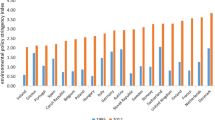Abstract
The analysis of endogenous growth models with pollution often concentrates on steady state trajectories, under the assumption that the steady state is in some sense stable. In the present note we provide examples showing that this issue should be dealt with carefully. We use the Rebelo “Ak” model augmented with a stock of pollutants causing a negative externality. It is found that optimal growth is not necessarily balanced (contrary to the outcome of the standard Rebelo model). Moreover, the existence of the externality may affect long run optimal growth rates.
Similar content being viewed by others
References
Barro, J. (1990), ‘Government Spending in a Simple Model of Endogenous Growth’,Journal of Political Economy 98(5), S103-S125.
Bovenberg, A. and S. Smulders (1993), ‘Environmental Quality and Pollution Saving Technological Change: A Two-Sector Endogenous Growth Model’, mimeo, Tilburg University.
Brock, W. and J. Scheinkman (1976), ‘Global Asymptotic Stability of Optimal Control Systems with Applications to the Theory of Economic Growth’,Journal of Economic Theory 12, 164–190.
Forster, B. (1973), ‘Optimal Capital Accumulation in a Polluted Environment’,Southern Economic Journal 39, 544–547.
Gottinger, H. (1993), Two essays in energy economics: long run investment and technical progress in dynamic and vintage models.
Gradus, R. and S. Smulders (1993), ‘The Trade-off between Environmental Care and Long-Term Growth-Pollution in Three Prototype Growth Models’,Journal of Economics 58, 25–51.
Hofkes, M. (1993), ‘Some Notes on the Concept of Sustainable Development in Endogenous Growth Models’, mimeo, Free University, Amsterdam.
Huijberts, H. and C. Withagen (1992), ‘Local Asymptotic Stability of Optimal Steady States’,Economics Letters 40, 7–11.
Keeler, E., M. Spencer, and R. Zeckhauser (1971), ‘The Optimal Control of Pollution’,Journal of Economic Theory 4, 19–34.
Lucas, R. E. (1988), ‘On the Mechanics of Economic Development’,Journal of Monetary Economics 22, 3–42.
Marrewijk, Ch., C. de Vries, and C. Withagen (1992), ‘Optimal Localized Production Experience and Schooling’,International Economic Review 33, 91–110.
Michel, P. and G. Rotillon (1993), ‘Pollution's Disutility and Endogenous Growth’, mimeo, Université de Paris.
Ploeg, F. v.d. and C. Withagen (1991), ‘Pollution Control and the Ramsey Problem’,Environmental and Resource Economics 1, 215–236.
Ploeg, F. van der, J. Verbeek, and C. van Marrewijk (1993), ‘Pollution, Abatement and Endogenous Growth’, mimeo, Erasmus University, Rotterdam.
Rebelo, S. (1991), ‘Long Run Policy Analysis and Long Run Growth’,Journal of Political Economy 99, 500–521.
Romer, P. M. (1986), ‘Increasing Returns and Long Run Growth’,Journal of Political Economy 94, 1002–1037.
Smulders, S. and R. Gradus (1993), ‘Pollution Abatement and Long-Term Growth’, mimeo, Tilburg University.
Vellinga, N. (1993), ‘Endogenous Growth and the Environment: Increasing Returns to Scale and Human Capital’, mimeo, Eindhoven University of Technology.
Author information
Authors and Affiliations
Additional information
The author is grateful to an anonymous referee for comments. All remaining errors are the author's sole responsibility.
Rights and permissions
About this article
Cite this article
Withagen, C. Pollution, abatement and balanced growth. Environ Resource Econ 5, 1–8 (1995). https://doi.org/10.1007/BF00691906
Issue Date:
DOI: https://doi.org/10.1007/BF00691906




